How to Add Depth When Coloring Freely
This week, we will color freely on a watercolor background and learn about adding depth to our colorings. I am using regular colored pencils, but you can also use watercolor pencils.

My drawing is inspired by the garden and the ornamental shapes of the plants, insects, and birds. So, let’s go deep in the garden and create lushness!
Quick Start with Watercolors
Blank paper can feel intimidating, but if you fill it first with watercolors, coloring is fun.
I was going through my paper pads when I found an unfinished watercolor painting.

It was just a background with random spots but the paper was smooth, just perfect for colored pencils. I think the paper is Arches Aquarelle Hot Press, nice and sturdy, 300 gsm/140 lbs thick.
I picked up my pencils and started drawing and let my inspiration come from the painted shapes.

I drew flowers, leaves, swirls, and all kinds of odd organic shapes that I would then later adjust.
Add Depth – Expand the Outlines!
When you draw, don’t just outline, but broaden the lines to form larger areas. For example, a black outline can be broadened so that it gradually gets lighter (“shadowing”) or so, that it remains dark and solid but expands to a larger and exciting shape.
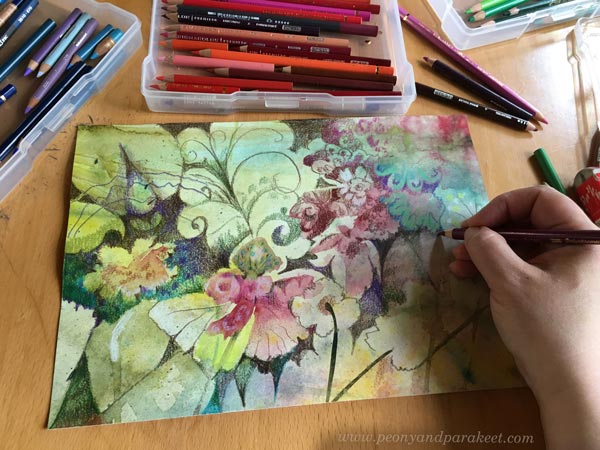
Dark and light should have clear differences so that you can point out separate areas: here’s dark, here’s light, here’s dark again, and so on.
Adding Depth is a Slow Process
When you are working without any references, you are on an adventure! What first looked like a flower, can become a butterfly after a while. Art is a shy fairy and it takes time to attract it.
In this intuitive coloring style, adding depth is a process where you slowly brighten or darken different areas. Start with a transparent layer, then add another one. When you have areas that haven’t been worked on with colored pencils yet, you can also use watercolors for layering.

Compared to accurately replicating a photo, this kind of free coloring may first feel much faster. But if you aim for depth, it’s not!
Add Depth – Find the Spirit!
At some point, your piece feels full and finished. But at this point, let me ask you a question:
Have you found the spirit of your piece?
Have you found something soulful that seems too gentle for this world?
Or is there something that cuts your heart and feels painful?
The depth in art is not only visual but something that evokes emotion.

In my piece, I discovered a spirit in the right upper corner. It’s not a flower or anything recognizable, but I felt it strongly.
After you have found the spirit, give more visibility to it. Make it so that it impacts the overall piece.
You Are the Sun
In your art, you are the sun. First, you can bring warmth to the piece by adding yellow. If you have areas that still take in watercolors, add a yellow wash over the greyish tones and let the warmth in.

Second, remember that you really are the sun. So, you can decide how the light travels and where the shadows are. You don’t need to calculate how the shadows should go like there would be one correct solution. Start deciding who deserves the sunshine, and who doesn’t! Who gets more color, and who will stay more in the shadow?
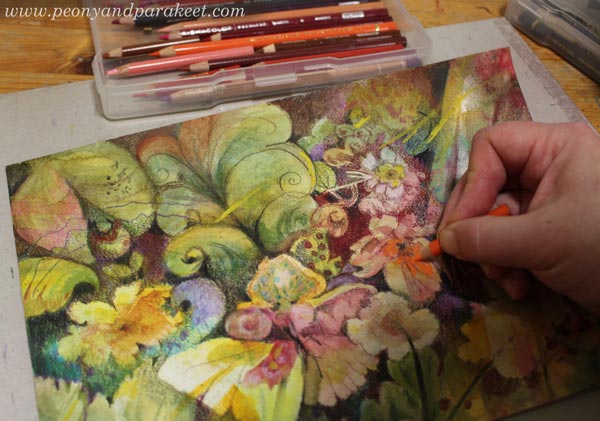
In nature, there are all kinds of reflections, and I find them artistically inspiring. Look at this photo that I took today from our garden pond!
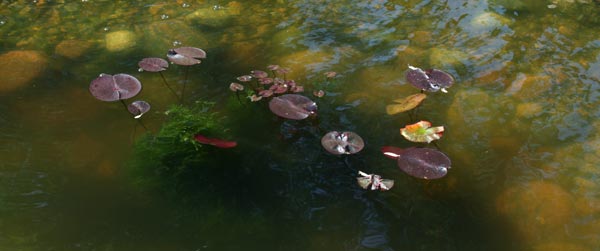
Playing with light, shadow, colors, and reflections is a lot of fun when you are creating freely. Remember that there’s no “shadow judge”, only “sun goddess” – you!
Add Depth – Force Yourself to Choose the Winners
Some people think about the composition all the time when they are creating, but I try to push that urge away as long as I can. You may have a lot of stuff on paper, but if you only highlight your favorites, balancing is easy. The problem is that you really have to choose!
Here, I have turned the paper upside down to get a different view of my work. That yellow flower looks very pretty, but the yellow butterfly shape near it is maybe even more attractive. Decisions, decisions!
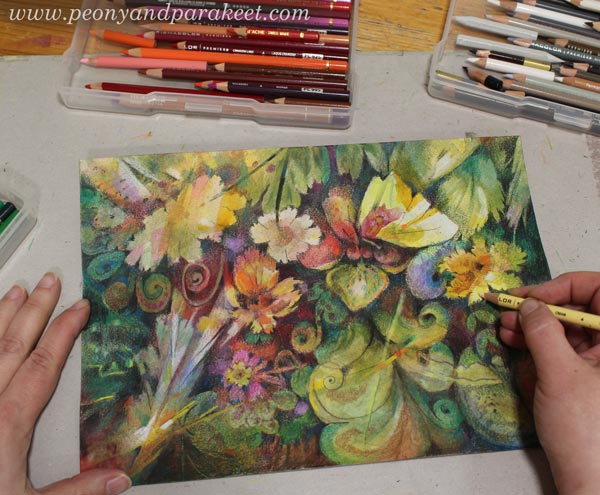
When I was at this point, I thought this was finished.
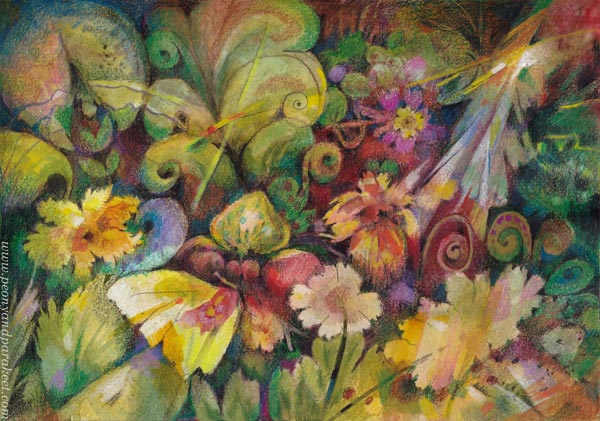
But when you want to add more depth, you want to reduce the competition for attention. I wanted to make the spirit in the upper right corner and the yellow butterfly clear winners even if it meant I pushed back many pretty things.
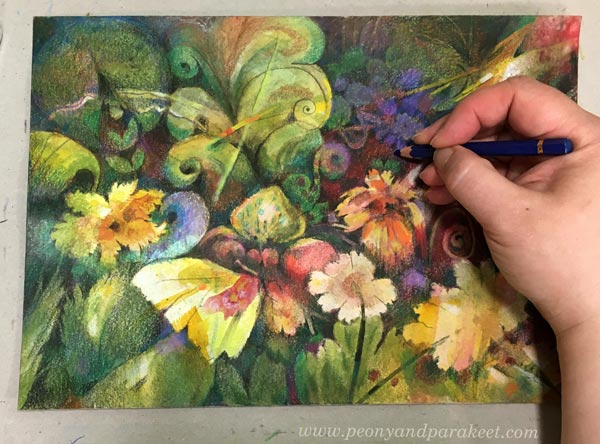
For example, the pink rose got toned down.
Room for Imagination
Things that are further away are blurry, like whispers, and things that are close, are sharp and louder. If everything shouts, and nothing whispers, the viewer will likely turn away. And vice versa, if everything only whispers, the viewer easily walks by.

If depth is lacking, you look at a wall and can’t see further. Depth is not only the impression but the imagination. With depth, you begin to imagine what more could be there. That’s especially why I want to add depth to my art whatever the subject is.
Learn more about watercolors and colored pencils together: See my course Freely Grown!
10 thoughts on “How to Add Depth When Coloring Freely”
Comments are closed.
Thank you for a dose of your beautiful work! It was just what I needed today XO
Thank you, Brenda!
This is stunning! Your art continues to inspire me. I think darkening the pink flower to purple gave the piece more depth, though it would have been hard for me to do. That lovely purple flower makes the yellow explode all the more. Happiness 😊
Thank you, Melinda! Yes, it’s often really difficult to cover little things that look so endearing. I often ask myself: is this one more important than that one? Making these choices is hard but in the result, the small bits and pieces distract and reduce the overall impact.
You are a great teacher – inspiring and informative! I am going to try some intuitive coloring. I have lots of watercolor backgrounds.
Thank you, Berverly! Have fun!
Hi Päivi!
Just love this and will try something similar, I think. “You are the sun”: what a wonderful way to think when you are painting plants and flowers. This might change one’s way of “being” when executing your world of nature. And the “spirit” you mention is all important.
Thanks,
Louisa Ellingham
Thank you, Lynne, I am glad this inspired you!
Thank you Paivi for sharing your beautiful artwork and knowledge!
Thanks, Robin!!